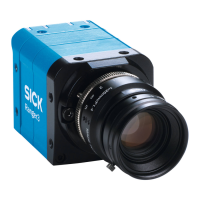8 Configuration
8.1 Software installation
8.1.1 System recommendations
The PC requirements for the vision system will depend on your application, but as a
general guideline the following is recommended for minimal operation:
•
Windows 10, 64 bit.
•
Gigabit Ethernet adapter that supports Jumbo Frames and is dedicated for camera
communication, see "Recommended network card settings", page 110.
8.1.2 Network preparations
Due to the large amount of data that the camera delivers per second, it is required
to connect it to the PC using a dedicated Gigabit Ethernet network, without other
interfering traffic. If the PC must be connected to other equipment, for example network
printers, the PC should be equipped with (at least) two network interface cards (NIC).
Multiple cameras can be connected using a NIC with multiple ports, or multiple NICs.
To connect multiple cameras to a single NIC limits the maximum speed of the cameras.
For best performance, connect each camera to a separate NIC.
For recommended network settings, see "Recommended network card settings",
page 110.
8.1.3 Installing PC software
The latest version of the Ranger3 software development kit (SDK) can be down‐
loaded from the SICK Support Portal, supportportal.sick.com/products/vision/3d-
vision/Ranger-series/ranger3/.
1. Log in to the SICK Support Portal.
2. Under Releases, click the link corresponding to the latest
version of the Ranger3 SDK.
3. Download the SDK zip file.
4. Unzip the SDK and follow the instructions in the
README.txt file.
The SDK contains the Ranger3 Studio software application, which is used for the con‐
figuration and operation procedures described in this manual. To start the application,
open the Ranger3 Studio sub-folder and click the Ranger3 Studio.exe file.
8.2 Concepts
The GenICam™ standard uses "feature" as a common word for parameters, com‐
mands, and selectors.
8.2.1 Selectors
In a GenICam™ device, such as Ranger3, selectors are used to access parameters that
are organized in arrays. That is, the selector acts as the index for the affected parame‐
ters. Changing the selector does not change any parameter. A parameter indexed by a
selector is notated ParameterA[SelectorX].
Example: The parameter Width[RegionSelector] sets the width of a region. The value of
RegionSelector decides which region that is manipulated. This means that Width[Region1]
is the width of the region named Region1.
CONFIGURATION 8
8020774/1D7Q/2022-03 | SICK O P E R A T I N G I N S T R U C T I O N S | Ranger3
31
Subject to change without notice

